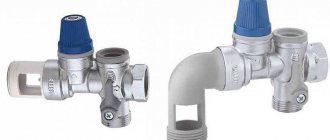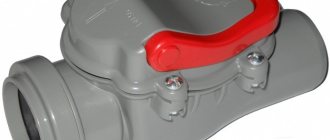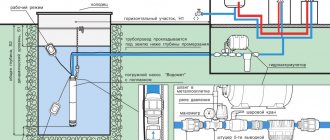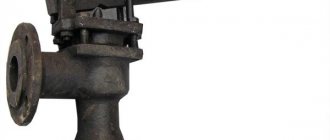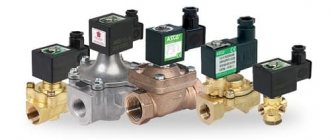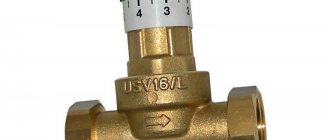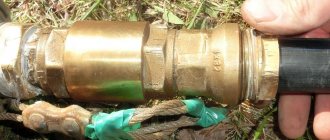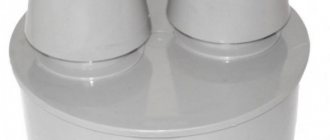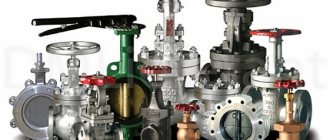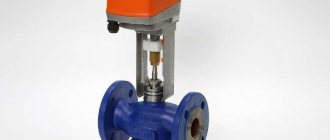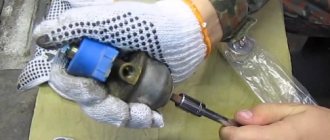The main task that a flanged check valve, installed on pipelines for various purposes, solves is to ensure the movement of the transported medium in one direction. The design features of the check valve, for the installation of which a flange is used, allow such a device to automatically stop the movement of the transported medium at the moment when such movement begins to occur in the wrong direction. Flange-type check valves are installed primarily on pipelines through which liquid media are pumped.
Cast iron wafer check valve in the water meter assembly
Features and applications of check valves
Check valves of various types (including flanged) are used to protect pipelines from:
- the occurrence of reverse flows of the working environment in it;
- hydraulic shocks.
Reverse flow in pipelines, as is clear from its name, is the movement of the working medium in the opposite direction. This can happen, in particular, when the pump that supplies the working fluid and moves it is turned off. If for heating systems such a phenomenon as reverse flow is not particularly critical, then in sewer and water supply systems, as well as in pipelines through which petroleum products and other media are transported, its occurrence cannot be allowed. That is why the use of check valves in such pipeline systems is a mandatory requirement.
Stainless steel flanged check valve designed for use in petroleum products environments
Another undesirable phenomenon from which pipeline systems can be protected by a flanged, wafer check or any other valve is water hammer. It is characterized by the fact that a sharp pressure drop in the transported medium occurs in the pipeline, which leads to the formation of a shock wave passing along the entire length of the pipeline system.
Water hammer can, over time, lead to the destruction of individual sections of the pipeline and the failure of elements that are used to ensure its normal operation. With the help of check valves installed using flanges or any other method, the system is divided into separate isolated sectors, which makes it possible to effectively protect it from the effects of water hammer.
Check valve disassembly
The check valve is disassembled in the following sequence:
First you need to unscrew the nuts, remove the flanges and washers. Then remove the shut-off valve, unscrew the cap and remove the casing, compress the diameter of the pipe and pull it out, remove the casing from the flanges.
The check valve is assembled, respectively, in the reverse order: a shell is put on the shut-off element and screwed on with a lid, the pipe is compressed and inserted into the body, then the shut-off element is installed in the body, the shell is put on the flanges, and they are also inserted into the body, then screwed studs, the valve is installed on the studs and the nuts and washers are tightened.
Disassembling the check valve installed in the water heater
Many people have water heaters in their homes and cottages; let's also pay attention to removing the check valve from the boiler. First you need to turn off the power to the electrical appliance. After unscrewing the nut, turn the cold water pipeline, unscrew the nut from the valve block, remove the sleeve, spring and the valve itself, clean the seat in the valve, and if necessary, replace the valve.
If the check valve cannot contain the flow of the working fluid, then the best option would be to call a specialist who is guaranteed to fix the problem. If a normal blockage occurs, you can handle it yourself: clean the valve with detergents and put it back. What is important is that safety precautions must always be followed.
Operating principle
The principle by which check valves operate is quite simple, however, such devices are very effective and are able to provide reliable protection of parts of pipeline systems. Any check valve, regardless of type, consists of a body (steel or cast iron) and a locking element located in it. The locking mechanism operates due to the pressure of a special spring, the rigidity of which can be adjusted.
The spring with which check valves are equipped ensures that their locking elements open in only one direction - in the direction of the correct movement of the transported medium. By exerting pressure on the shut-off element held by such a spring, the liquid or gas pumped through the pipeline opens it and begins to move in the required direction. As soon as the pressure of the working medium in the direction of opening the valve begins to fall, the shut-off element closes, preventing the liquid or gas from moving in the opposite direction.
Operating principle of a check valve
Types and properties
The design of the shut-off elements of check valves, for installation of which flanges are used, can be different. The choice of a flange valve with a certain type of locking element depends on the tasks for which such a device is intended.
So, depending on the design of the locking element, there are:
- rotary valve;
- lift type check valve;
- check valve with ball shut-off element;
- double-leaf check valve;
- intake check valve equipped with a mesh.
Design of some flange type check valves
A rotary check valve is a locking device, the main part of which is a steel slamming disk fixed on a spring-loaded axis. At the moment when such a check valve is open, the disk in its inner part is located parallel to the movement of the working medium, and when closed, it is perpendicular. The flange check valve has a simple design and, accordingly, low cost. If we talk about the disadvantages of check valves of this type, the most significant of them is that their rotating mechanism at the moment of closing slams the locking disk too tightly, which over time leads to wear of the seat. Rotary check valves, equipped with a special mechanism that ensures smooth closing of the locking disc, do not have this drawback. Meanwhile, such improved flanged rotary valves are more expensive, which somewhat limits their use.
Rotary check valve device
In flange-type lifting check valves, a special spool is used as a shut-off element, which, under the pressure of the working flow, rises along the vertical axis, and when the pressure decreases, it drops to its seat, blocking the movement of the medium transported through the pipeline. It should be borne in mind that such valves, due to their design features, can only be installed in a vertical position.
Ball check valves, as their name suggests, use a ball-shaped spool as a shut-off element. Their large size does not allow them to be used as wafer locking devices.
Flanged ball type check valve
A double-leaf check valve, which is produced mainly in a wafer design, involves the use of two slamming flaps simultaneously in its design. Each of them is connected to a spring, which regulates the strength of their resistance to the pressure of the working flow. The wafer-type double-leaf valve, due to the small size of its shut-off elements - the flaps - is characterized by very compact dimensions.
Check valves, which are additionally equipped with a strainer, are used for installation on pipeline systems for pumping oil, gas or water from underground sources. Such devices, the most popular model of which is 16CH42R, simultaneously solve two important problems: their locking mechanism prevents liquid or gas from returning back to the source, and the mesh protects the pipeline from large debris entering it.
The design of the 16CH42R valve varies depending on the dimensions of the product
Model 16Ch42R, the body of which is made of steel or cast iron, is characterized by wide versatility and can be installed on pipelines or pumps used for pumping both liquid and gaseous media.
Overall and connection dimensions of the valve 16х42р
Check valve installation
If your system requires plastic pipes, but there is a need to install a check valve, do not worry, this can be done quite easily. In this case, a transition from plastic to metal is installed in the plastic pipe, often with the end of the external thread. Next, use fum tape or flax with sealant to achieve maximum tightness. Having wound the flax as you wind the next section of the chain, install a check valve, which is tightened to the limit values using a plumbing wrench. On the other side of the check valve, similar actions are performed, after which they allow the sealant to dry a little and check the operation of the system.
Keep in mind that there is an arrow on the check valve that indicates the direction of water flow . Checking the position in which the valve opens is quite simple. Just blow in the direction of the arrow; if air passes through, it means the valve has opened. If you blow from the reverse side and air also passes through, then the system is faulty. Such a valve should not be installed.
Flanged and Wafer Check Valves: Differences
Check valves that use flanges for installation on piping systems can be one of the following types:
- flanged;
- wafer
On flange-type devices, the supply flange and the return flange are welded to the valve body and form a single unit with it. Flanged check valves are used primarily to equip large-diameter pipes, with the help of which working media are transported on an industrial scale.
On the left is a wafer valve, on the right is a valve with flange mounting
Wafer check valves have virtually no fastening elements. This type of installation, as mentioned above, is very often used for installing double-leaf check valves. In this case, the valve itself (in particular, a double-leaf wafer valve) is installed between two flanges fixed at the ends of the connected pipes. After its placement in special seats, which are equipped with sealing elements, the flanges are tightened together using threaded rods. Despite the apparent unreliability of such a connection, if it is made correctly, the wafer check valve is fixed with the same reliability as devices of any other type.
Check valves can be installed on pipeline systems using not only flanges, but also couplings or a welded connection. However, if we talk about large-diameter pipelines, such valves are installed on them only using flanges.
The installation method of the check valve depends on its design
Why is a water supply check valve needed?
In a country house, the hot water and cold water supply system is connected to an autonomous water source - a well, a well or a shallow spring. But even from a depth of 4-10 meters, water must be delivered to the house without loss, and the length of the water supply may vary. If a submersible or deep-well pump works constantly, then there will be no problems with delivering water to the pipes or storage tank in the right direction, but as soon as the pump turns off, water will not only stop flowing into the pipes - it will flow back into the well.
With a large length of pipes, each turn on of the pump will be accompanied by a significant time pause necessary for the pipeline to be refilled with water. That's what the valve is for - it speeds up the restart of the water supply by preventing air from filling any length of pipe.
Therefore, a check valve must be installed in the water supply to ensure that water flows only in one direction - when the direction of flow changes, the shut-off device blocks the water supply and the water remains in the pipes.
Advantages and disadvantages of flange type check valves
Since flange-type check valves are most often used to equip pipelines through which the working fluid is transported with high intensity, the internal elements of such devices (in particular, the shut-off mechanism) experience significant shock loads during operation. In addition, a flange-type check valve, due to its significant dimensions, itself causes water hammer. During the process of closing the valve flaps, the pressure in the pipeline in which it is installed inevitably increases, which leads to the formation of a water hammer.
In those pipeline systems in which water hammer is not able to have a significant impact on the performance of both individual elements and the system as a whole, simple type check valves are used. The diameter of the latter, as a rule, does not exceed 400 mm. In other cases, non-impact type check valves are used. Smooth and soft closing of the shut-off element in shockless flanged valves can be ensured by special weights or hydraulic dampers. Meanwhile, when choosing non-impact type check valves to equip a pipeline system, you should keep in mind that they can only be installed in horizontal sections.
Axial type flanged hammerless valve
The most significant advantages of flanged check valves include:
- compact dimensions, which allows the installation of such devices in almost any area of the pipeline system;
- the ability to operate effectively even in systems where the working environment is highly polluted;
- Possibility of installation on pipelines with large diameters.
Rules for installing a check valve on water
Protective fittings are used in autonomous water supply systems, intra-house water supply networks in apartment buildings, with separate centralized supply of cold and hot water. Check valves are installed on the suction line of surface and deep-well pumps, in front of water meters, boilers, and tank water heaters.
Spring back water pressure valves have no rubbing surfaces, so they can be installed in any position (vertical, horizontal or inclined). The arrow on the product body indicates the direction of movement of the medium; its vector must coincide with the installation position of the protective fittings.
The device requires regular maintenance. Install the check valve in a place accessible for cleaning, inspection, repair or replacement.
There is an arrow on the valve body that indicates the direction of water movement
Features of choice
The main parameters that you should pay attention to when choosing a check valve (including flanged ones) are:
- operating pressure at which such a device can operate;
- nominal diameter.
You can find out what operating pressure the check valve corresponds to by looking at the device’s marking, in which this parameter is designated by the letters RU. The numbers in the marking after such letters indicate the operating pressure for which the device is intended. For example, the designation RU16 indicates that a flanged valve can operate at a pressure of 16 bar without being subject to excessive wear.
Check valve marking
The nominal diameter, which determines which pipeline a flange-type valve can be installed on, is indicated by the letters DU. Accordingly, the numbers following these letters in the marking indicate the value of the nominal diameter of the check valve in millimeters. When choosing a check valve according to this parameter, keep in mind that such a product can only be mounted on pipeline elements that have the same dimensions. In other words, the DU80 model, for example, can only be installed on pipes or other elements of the pipeline system, the mounting diameter of which corresponds to 80 mm.
Where is the check valve installed?
Water supply shut-off valves are usually installed on a threaded connection near the water intake - on the surface or next to the submersible pump. The diameter of the mechanism must correspond to the diameter of the water conduit. Since the check valve in the water supply system is located next to the soil at the bottom of the water source, it is necessary to install a coarse mesh filter on it.
If the device is installed on a centrifugal submersible or deep diaphragm pump in a water supply system, then it should be mounted on a pipe or hose for more convenient placement in the well. If the shut-off mechanism is installed in a circuit with a surface pump, then it can be mounted on the surface, without a coarse filter, but if the installation of check valves in an autonomous water supply system with a submersible centrifugal pump is inevitable, then after the pump it is recommended to install another filter - a sealed flow-through one.
